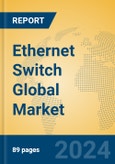Ethernet Switches are essential networking devices that connect multiple devices within a network, facilitating efficient data transfer across enterprise & campus settings, carrier Ethernet systems, and data centers. These switches manage traffic with precision, supporting the backbone of modern digital infrastructure amid rising demands for connectivity, cloud services, and IoT integration. Positioned within the networking hardware sector, this market thrives on its ability to handle increasing data volumes, driven by enterprise digitalization, telecom advancements, and data center expansion, with trends leaning toward high-port-density, energy-efficient designs.
This product will be delivered within 1-3 business days.
Market Size and Growth Forecast
The global Ethernet Switch market is estimated to be valued between USD 43 billion and USD 45 billion in 2025, with a projected CAGR of 4% to 6% from 2025 to 2030, potentially reaching USD 23 billion to USD 27 billion by 2030, reflecting steady network demand.Regional Analysis
- North America: Growing at 3-5%, the U.S. leads with enterprise and data center use, trending toward high-performance switches.
- Europe: With a 3-4% growth rate, Germany excels in campus networks, focusing on sustainable designs.
- Asia Pacific: Exhibiting a 5-7% growth rate, China dominates with telecom and manufacturing scale, trending toward cost-effective solutions.
- Middle East and Africa (MEA): Growing at 2-4%, the UAE advances with carrier networks, emphasizing reliability.
- South America: With a 2-3% growth rate, Brazil leads with enterprise growth, focusing on affordability.
Application Analysis
- Enterprise & Campus: Projected at 4-6%, it thrives on business connectivity, trending toward scalable, secure switches.
- Carrier Ethernet: Expected at 3-5%, it serves telecom needs, with high-reliability designs rising.
- Data Center: Growing at 5-7%, it drives high-speed demand, shifting to high-port-density solutions.
Product Type Analysis
- Modular Switches: Projected at 4-6%, they excel in flexibility, trending toward customizable deployments.
- Fixed-configuration Switches: Expected at 3-5%, they serve cost-effective needs, with compact designs rising.
Key Market Players
- Cisco Systems: A global titan in robust networking solutions.
- Huawei: A versatile innovator in scalable switches.
- Arista Networks: A dynamic leader in high-performance designs.
- HPE: A reliable provider of enterprise-grade systems.
- H3C: A spirited creator of cost-effective solutions.
- Juniper Networks: A strategic pioneer in secure networking.
- Broadcom: A precision innovator in switch technologies.
- D-link: A practical provider of accessible switches.
- Allied Telesis: A resourceful leader in reliable designs.
- Alcatel-Lucent Enterprise: A vibrant innovator in campus solutions.
Porter’s Five Forces Analysis
- Threat of New Entrants: Medium, with technical and brand barriers, though niche players emerge.
- Threat of Substitutes: Medium, as wireless competes, yet Ethernet’s reliability sustains demand.
- Bargaining Power of Buyers: High, with enterprises negotiating, balanced by performance needs.
- Bargaining Power of Suppliers: Medium, as chip reliance grants leverage, offset by scale.
- Competitive Rivalry: High, with innovation and pricing driving intense competition.
- Impact of Tariff Conflicts on Supply Chain Localization
Market Opportunities and Challenges
Opportunities
- Enterprise digitalization: Rising connectivity needs drive demand, enhancing switch adoption.
- Data center growth: Cloud expansion fuels use, targeting high-speed solutions.
- IoT proliferation: Device connectivity boosts need, supporting network scalability.
- Emerging market potential: Telecom growth in Asia Pacific offers avenues, fueled by scale.
- Energy efficiency: Green designs gain traction, appealing to sustainable trends.
Challenges
- High costs: Expensive production limits affordability, challenging scale.
- Substitute rivalry: Wireless tech threatens share, needing differentiation.
- Price pressure: Competitive pricing squeezes margins, demanding efficiency.
- Supply chain risks: Component shortages disrupt production, testing operations.
- Regulatory complexity: Standards raise costs, slowing expansion.
This product will be delivered within 1-3 business days.
Table of Contents
Chapter 1 Executive SummaryChapter 2 Abbreviation and Acronyms
Chapter 3 Preface
Chapter 4 Market Landscape
Chapter 5 Market Trend Analysis
Chapter 6 Industry Chain Analysis
Chapter 7 Latest Market Dynamics
Chapter 8 Trading Analysis
Chapter 9 Historical and Forecast Ethernet Switch Market in North America (2020-2030)
Chapter 10 Historical and Forecast Ethernet Switch Market in South America (2020-2030)
Chapter 11 Historical and Forecast Ethernet Switch Market in Asia & Pacific (2020-2030)
Chapter 12 Historical and Forecast Ethernet Switch Market in Europe (2020-2030)
Chapter 13 Historical and Forecast Ethernet Switch Market in MEA (2020-2030)
Chapter 14 Summary For Global Ethernet Switch Market (2020-2025)
Chapter 15 Global Ethernet Switch Market Forecast (2025-2030)
Chapter 16 Analysis of Global Key Vendors
List of Tables and Figures
Companies Mentioned
- Cisco Systems
- Huawei
- Arista Networks
- HPE
- H3C
- Juniper Networks
- Broadcom
- D-link
- Allied Telesis
- Alcatel-Lucent Enterprise








